The Ultimate Guide to Nano Fish for Your Aquarium
This guide is expert knowledge, scientific data, and thousands of hours of community experience to provide the definitive resource on nano fish selection and care. We’ll explore the best species, from beginner-friendly to expert-only, and reveal the critical system-building principles that ensure success in the delicate world of miniature aquariums.
Tier 1: The beginner trinity (easiest to keep)
Ember Tetra (Hyphessobrycon amandae)
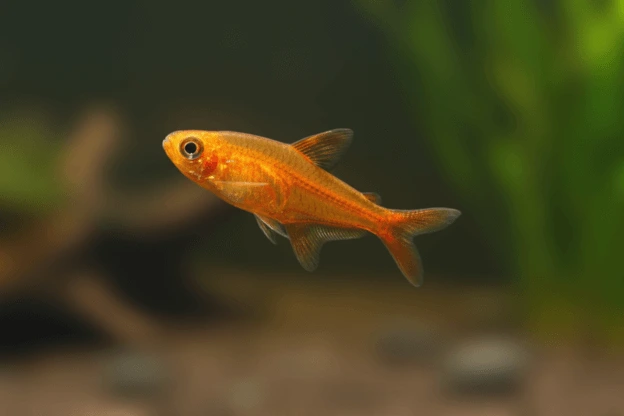
Ember Tetra (Hyphessobrycon amandae) earns its reputation as the ultimate beginner nano fish. Measuring just 0.6-0.8 inches at maturity, these bright orange-red tetras accept all foods readily, tolerate wide parameter ranges (pH 5.0-7.0, temp 73-84°F), and cost roughly $3-4 each. Community consensus from forums confirms they spawn readily even in hard tap water and live 2-4 years with proper care. Their vibrant coloration intensifies with quality diet and planted tanks, making them stunning in groups of 10+. Minimum 10 gallons with 8+ individuals creates impressive schools. They’re generally shrimp-safe with adults but may opportunistically eat shrimplets.
Chili Rasbora (Boraras brigittae)

Chili Rasbora (Boraras brigittae) represents the smallest commonly available nano fish at 0.6-0.8 inches. Their deep scarlet red coloration with bold black lateral stripes creates dramatic visual impact when schools of 10-20 swim together. Native to Borneo blackwater streams, they prefer soft, acidic water (pH 4.0-7.0, temp 68-82°F) but captive-bred specimens adapt well. At $4-6 each, they’re affordable despite their tiny size. Critical warning from community experience: they are aggressive jumpers—multiple keepers report losing entire schools in open-top tanks within months. Require tight-fitting lids absolutely. They school tightly when comfortable and live 4-8 years, making them long-term investments.
Pygmy Corydoras (Corydoras pygmaeus)

Pygmy Corydoras (Corydoras pygmaeus) breaks the bottom-dweller mold by swimming in midwater schools unlike typical corydoras. At 1-1.2 inches, these adorable catfish display silver bodies with thin black horizontal stripes and cost $5-7 each. They tolerate wide parameters (pH 6.4-7.4, temp 72-79°F) and accept all sinking foods. Forums report them as “adorable little fish” that “swim in all regions of the tank.” Groups of 6+ are mandatory, with 10-15 creating stunning displays. Critical requirement: fine sand substrate only—sharp gravel will damage their sensitive barbels and cause fatal infections. They breed readily in captivity (3-5 year lifespan) and remain completely shrimp-safe.
Tier 2: Popular choices requiring more care
Celestial Pearl Danio (Danio margaritatus)

Celestial Pearl Danio (Danio margaritatus), also called Galaxy Rasbora, became the aquarium sensation when discovered in 2006. Males display deep blue bodies covered in cream pearl-like spots with bright red/orange fins featuring black stripes—truly stunning at 0.75-1 inch. Females appear duller blue-green with shorter fins. At $4-10 each, they’re affordable and captive-bred worldwide. Myanmar initially banned exports due to overcollection fears, but surveys found populations in multiple locations.
They tolerate neutral to alkaline water (pH 6.5-7.5, temp 68-78°F, GH 90-268 ppm) and live 3-5 years, with some reports of 8+ years. Critical caveat: males are territorial and aggressive toward each other without heavy planting. Community forums emphasize “what looks like dancing is actually aggressive territorial behavior.” Minimum 10 gallons with 10-20+ specimens and dense vegetation with dark substrate required. They shoal loosely rather than schooling tightly. Generally shrimp-safe with adults but will eat shrimplets.
Scarlet Badis (Dario dario)

Scarlet Badis (Dario dario) stands out as a brilliant red/orange micro-predator with seven iridescent blue vertical bars—among the most beautiful percoid fish at just 0.8 inches (males) or 0.5 inches (females). They cost $6-10 each but come with significant challenges. Forums unanimously warn: females are extremely hard to find, with mostly males sold. They’re strict micropredators usually refusing dry foods entirely, requiring live foods like baby brine shrimp, daphnia, microworms, and grindal worms. Avoid bloodworms and tubifex causing obesity.
Males are very aggressive toward other males, requiring 20+ gallons for multiple males or 10 gallons for one male with 2-3 females. They tolerate wide parameters (pH 6.5-8.5, temp 64-79°F) but remain very sensitive to poor water quality requiring 50% weekly water changes. They’re mostly shrimp-safe with adults but eat shrimplets. Cave spawners with males guarding eggs, they live 3-6 years. Not recommended for beginners due to specialized feeding requirements and water quality sensitivity.
Endler’s Livebearer (Poecilia wingei)
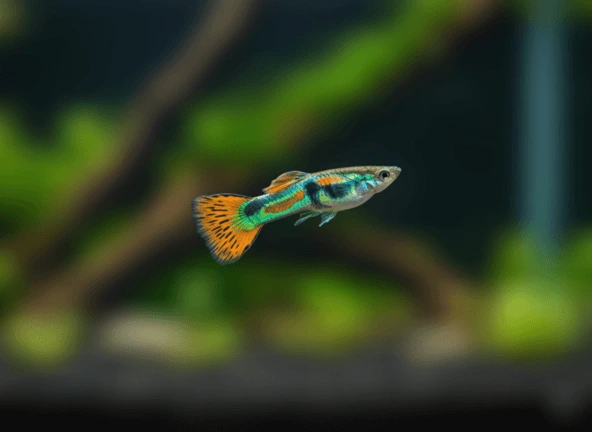
Endler’s Livebearer (Poecilia wingei) offers explosive color variety in males displaying orange, red, green, blue, and black patterns on 1-inch bodies. Females reach 1.8 inches but appear plain silver/tan. At $3-5 each, they’re beginner-friendly livebearers tolerating extreme parameter ranges (pH 6.5-8.5, temp 64-84°F, any hardness). They’re so easy they breed prolifically without intervention in planted tanks—have plans for offspring or they’ll overrun the system.
Three classes exist: N-Class (pure strain), P-Class (unknown origin), K-Class (guppy hybrids). Keep purebred strains separate from guppies to maintain genetics. They live 2-3 years and work well in 10+ gallon tanks with 5-6 minimum, preferring 2-3 females per male. Generally shrimp-safe with adults but may predate shrimplets. Can tolerate room temperature without heaters in appropriate climates, making them excellent for unheated nano tanks.
Tier 3: Specialized species for specific setups
Green Neon Tetra (Paracheirodon simulans)
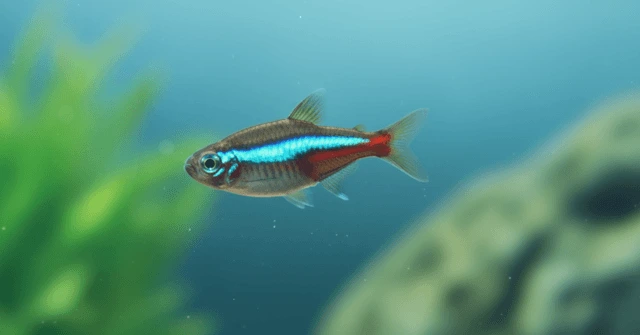
Green Neon Tetra (Paracheirodon simulans) appears similar to regular neons but displays more green than blue in the lateral stripe, reaches smaller size (0.6-1 inch), and costs $4-6 each. Native to blackwater Rio Negro systems, they prefer soft, acidic water (pH 3.0-6.5, temp 70-95°F surprisingly tolerant). 100% wild-caught—no commercial breeding exists, making ethical sourcing critical. They’re more expensive and sensitive than regular neons, requiring stable, pristine water in biologically mature aquariums only.
Groups of 8-10 minimum (12+ preferred) create subtle but beautiful schools. They’re shrimp-safe and live 3-5 years. Community notes they’re less bold than regular neons and need dim lighting with heavy vegetation. Prefer blackwater conditions with tannins from driftwood and Indian almond leaves.
Clown Killifish (Epiplatys annulatus)

Clown Killifish (Epiplatys annulatus) displays stunning alternating vertical bands of black and cream/yellow with males showing vibrant red, yellow, blue, and orange in flame-like tail fins. At 1.2-1.4 inches and $5-8 each, they’re true surface-dwelling dart-shaped rockets hunting insects at the water’s surface with upturned mouths. They prefer soft, acidic water (pH 4.0-7.0, temp 67-80°F) with blackwater conditions ideal.
Absolute requirement: tight-fitting lids—excellent jumpers that will escape open tanks. They’re strict carnivores/insectivores preferring live foods like fruit flies and mosquito larvae, though some accept floating micro pellets after acclimation. Keep groups of 6-8+ with 1 male to 2-3 females as males can be territorial during breeding. They’re generally shrimp-safe with adults but eat baby shrimp. Egg scatterers breeding on plants/moss with eggs hatching in 9-14 days, they live 2-3 years (longer at cooler temperatures). Best in species-only nano tanks with minimal flow from sponge filters.
Sparkling Gourami (Trichopsis pumila)
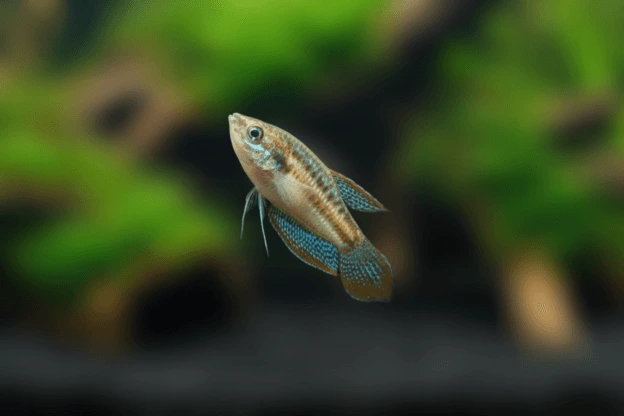
Sparkling Gourami (Trichopsis pumila) offers unique appeal as one of the only fish that makes audible sounds—croaking/clicking noises via pectoral mechanisms like guitar strings. At 1-1.6 inches, they display iridescent blue, green, and red shimmers under lighting with brown bodies featuring light blue polka dots. Males are more colorful with pointed fins. They cost $4-7 each.
As labyrinth fish breathing atmospheric air, they frequent the surface and build bubble nests like bettas during breeding. They prefer soft, slightly acidic water (pH 6.0-7.5, temp 72-82°F) with blackwater conditions ideal. Critical warning: they are micropredators known to hunt and kill dwarf shrimp in groups—not ideal for shrimp tanks unlike most nano fish. Keep groups of 5-7 with 3:1 female-to-male ratio minimum. Require heavily planted tanks with dim lighting and slow flow or they’ll stress. Feed live/frozen foods primarily. They live 4-5 years and are fascinating to hear “talk” but not suitable for bare or brightly-lit setups.
Additional highly recommended species
Norman’s Lampeye Killifish (Poropanchax normani)

Norman’s Lampeye Killifish (Poropanchax normani) earns its name from the horizontal crescent on top of the iris glowing brilliant blue under aquarium lighting. These 1.2-1.6-inch surface dwellers display creamy/silvery-white bodies with subtle blue/green iridescence and cost $4-6 each. Native to Central/West Africa where they’re found in thousands, they’re peaceful shoaling fish preferring groups of 10+ in 10-15+ gallon tanks.
They tolerate soft to moderate water (pH 6.5-7.0, temp 72-78°F) and primarily eat live/frozen foods like baby brine shrimp, though they may accept flakes after acclimation. Critical warning: excellent jumpers requiring tight-fitting lids or lower water levels—multiple keepers report losses. They’re shrimp-safe with adults and breed relatively easily as egg scatterers on Java moss. They live 2-5 years and work well with other tiny peaceful species. Community notes they “can lose lamp glow temporarily when stressed or shocked” but it returns.
Emerald Dwarf Rasbora (Celestichthys erythromicron)
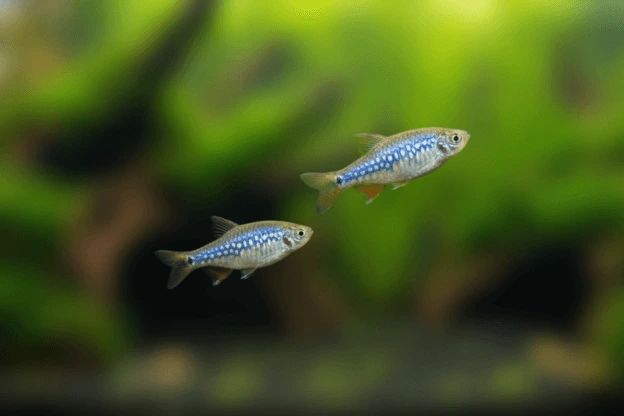
Emerald Dwarf Rasbora (Celestichthys erythromicron) displays coral pink/orange bodies with thick emerald green vertical stripes and large shimmering eyes at 1-1.5 inches. They cost $5-8 each and prefer cooler water than most tropicals (68-75°F optimal, prefers UNDER 77°F). Critical distinction: they prefer neutral to alkaline pH (7.0-7.8) and moderate to hard water—opposite of most rasboras preferring acidic conditions. Endemic to Lake Inle, Myanmar at 3,000 ft elevation in limestone-based alkaline water.
They’re generally beginner-friendly once established, accepting a wide diet including quality micro pellets. Keep groups of 6-8 minimum with 20+ creating confident schools in heavily planted tanks. Require strong filtration (4-5x tank volume per hour) due to waste production despite small size. They’re excellent shrimp-safe species living 3-5 years. Wild populations are threatened by pollution and habitat destruction, but captive-bred specimens are readily available.
Least Killifish (Heterandria formosa)

Least Killifish (Heterandria formosa) holds the title of smallest livebearer in the world at 0.8 inches (males) or 1.4 inches (females). These $3-5 fish display unique superfetation reproduction—carrying multiple stages of embryos simultaneously and dropping 1-3 fry every few days rather than large broods. At $3-5 each, they’re budget-friendly and hardy for beginners tolerating wide parameters (pH 7.0-8.0, temp 68-79°F, even brackish conditions).
Keep groups of 6+ minimum with 15+ creating confident schools. Recommended ratio: 3-4 males per female to mimic natural populations. Warning: in groups they may gang up on baby shrimp, though small numbers usually leave shrimp alone. They’re peaceful but can be initially shy, becoming bold in large groups. Adults typically don’t eat their own fry in planted tanks. They’re subtropical and can be kept without heaters in appropriate climates. Wild specimens live only 120-150 days, but captivity extends lifespan to 1.5 years. Temperature significantly affects lifespan—cooler conditions extend longevity.
Pseudomugil Blue Eye Species (multiple species in genus)
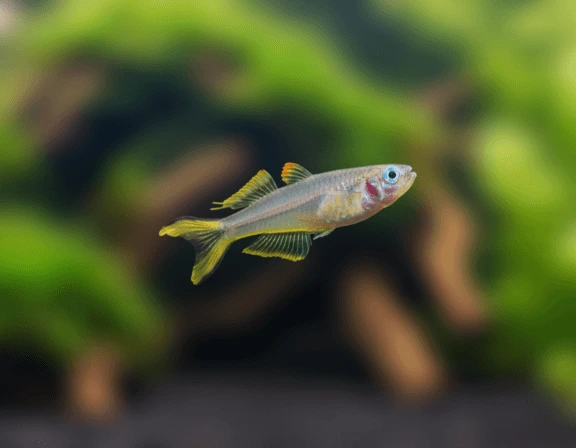
Pseudomugil Blue Eye Species (multiple species in genus) offer stunning iridescent blue eyes with yellow, orange, and blue body coloration. The most popular include Red Neon Blue Eye (P. luminatus) at 1.4 inches showing neon red to red-orange coloration (described 2016, considered Endangered), Forktail Blue Eye (P. furcatus) at 2-3 inches with distinctive forked tails, and Gertrude’s Spotted Blue Eye (P. gertrudae) under 1.5 inches with iridescent yellow-blue males.
These dwarf rainbowfish cost $6-12 each and prefer hard, alkaline water (pH 7.0-8.5+, temp 72-82°F)—excellent alternatives to South American tetras for hard water areas. They’re omnivorous accepting high-quality dry foods supplemented with frozen/live foods. Males display extended, fan-like fins and intensify coloration during courtship. They’re peaceful schooling species requiring large groups in 15-20+ gallon tanks due to activity levels. Generally shrimp-safe with adults, they breed readily in captivity and live 2-4 years. Can tolerate brackish to full marine water depending on species (P. cyanodorsalis unique).
Building beginner-proof systems from day one
The cycling truth that saves fish lives
The single most critical mistake beginners make is not cycling tanks—adding fish before beneficial bacteria establish causes ammonia poisoning and rapid death. Forums overflow with “I just set up my tank 3 days ago and my fish are dying. Ammonia is 4ppm!” examples. Cycle tanks for 4-6 weeks minimum before introducing fish, testing weekly for ammonia (must reach zero), nitrite (must reach zero), and nitrate (must show presence indicating cycle completion).
Fishless cycling with pure ammonia or bottled bacteria (Seachem Stability, Fritz Turbo Start) speeds the process. In nano tanks, cycling is even more critical due to small water volumes providing no margin for error. Consider the tank fully cycled only when it can process 2-4 ppm ammonia to nitrate within 24 hours without nitrite spikes.
The overstocking trap compounds rapidly
Small water volumes make overstocking catastrophic in ways 50-gallon tanks forgive. Nano keepers consistently report “I have 6 fish in my 5 gallon and they keep dying” or “added all my fish at once and tank is cloudy with high ammonia.” The traditional “1 inch per gallon” rule misleads—it ignores bioload, activity level, and body shape. Better approach: 0.5-0.75 inch per gallon for nano fish with conservative stocking.
Add fish slowly over weeks/months rather than all at once, allowing beneficial bacteria colonies to expand gradually. Monitor water parameters closely after each addition. Under-stock rather than over-stock in tanks under 20 gallons. Forums universally agree “the smaller the tank, the less margin for error.”
Common beginner mistakes that crash systems
Overfeeding ranks as the #1 killer after inadequate cycling. Excess food causes ammonia spikes, cloudy water, and algae blooms. Feed only what fish consume in 2-3 minutes once daily, skipping one day per week entirely. Remove uneaten food immediately. Nano fish need tiny food particles—crush flakes and pellets for mouths under 1 inch.
The “small tanks are easier” myth destroys countless fish. Expert consensus confirms “bigger tanks are ALWAYS easier for beginners” because parameters swing wildly in small volumes. Temperature fluctuates dramatically, mistakes compound quickly, and small changes have massive impacts. Test water 2x weekly minimum in nano tanks. If possible, start with 10+ gallons rather than 5 gallons despite the appeal of tiny tanks.
Incompatible fish selection stems from poor research and trusting pet store advice blindly. Forums document “my betta killed all my guppies” and “my CPDs chase each other constantly” from impulse purchases. Research thoroughly before buying, match fish to your water parameters rather than chasing pH, and in tanks under 10 gallons, stick to ONE species only.
Never turn off filters at night—multiple forum posts describe “filter noise bothered me so I turned it off at night, now fish are dying.” Beneficial bacteria die without oxygen flow. Filters run 24/7 without exception—use quieter models or relocate tanks if noise is problematic. Rapid or 100% water changes cause parameter swings—perform 20-30% weekly changes matching new water temperature and always using dechlorinator.
Essential equipment specifications
Filtration proves most critical in nano systems where rapid water quality changes require robust biological filtration. For 5-gallon tanks use small hang-on-back (HOB) filters or sponge filters (Aquarium Co-op sponge filters earn community recommendations). For 10-gallon tanks choose HOB filters rated for 20 gallons—over-filtering nano tanks creates stability. For 20-gallon tanks employ canister filters or dual HOB units providing 4-6x tank volume per hour flow.
Clean filters monthly but never replace all media at once—this kills beneficial bacteria colonies. Rinse mechanical media in old tank water (never tap water) and replace only when falling apart. Keep biological media indefinitely.
Heater sizing matters tremendously in nano volumes where oversized heaters cause overheating. Use 25-50W preset heaters for 5 gallons, 50W adjustable for 10 gallons, and 100W adjustable for 20 gallons. Place near filter output for even heat distribution. Target 75-78°F for most tropical species. Some nano fish (White Cloud Mountain Minnows, Emerald Dwarf Rasboras, Endlers) tolerate room temperature without heaters.
Lighting requirements depend on plants—fish-only tanks need any basic LED for 6-8 hours daily, but planted tanks require full-spectrum LEDs (Nicrew, Hygger, Finnex recommended) at 1-2 watts per gallon for low-tech setups. Start with 6-8 hours daily and adjust if algae appears.
Substrate choice impacts fish health directly. Corydoras species require fine sand or very smooth substrate—sharp gravel damages sensitive barbels causing fatal infections. Community forums emphasize “pygmy corys will die if barbels are damaged from rough substrate.” Use 1-1.5 inch depth sloped toward back for depth perception. Aqua soil (ADA, Fluval Stratum, UNS Controsoil) works best for heavily planted tanks.
Water chemistry demystified for beginners
pH measures acidity/alkalinity on a logarithmic 0-14 scale where pH 6 is 10x more acidic than pH 7. Most captive-bred nano fish tolerate 6.5-7.8 range. Stability matters far more than “perfect” numbers—chasing pH with chemicals causes dangerous swings. Choose fish matching your tap water rather than adjusting water to match fish preferences. Soft water fish (6.0-7.0) include South American tetras, rasboras, and corydoras. Hard water fish (7.5-8.5) include livebearers like guppies, platys, mollies, and African cichlids.
General Hardness (GH) measures calcium and magnesium affecting osmoregulation and bone/scale development. Scale: 0-4 dGH (0-70 ppm) = very soft, 4-8 dGH (70-140 ppm) = soft, 8-12 dGH (140-210 ppm) = medium hard, 12-18 dGH (210-320 ppm) = fairly hard, 18+ dGH (320+ ppm) = hard. Most community fish thrive at 6-12 dGH. Shrimp need calcium for molting—Neocaridina prefer 6-12 dGH while Caridina need 4-6 dGH soft water.
Carbonate Hardness (KH) measures buffering capacity preventing pH crashes. Think of KH as a trash can—high KH creates large trash can keeping pH very stable, while low KH creates small trash can allowing pH swings. Maintain 4-7 dKH for most tanks. Below 4 dKH requires weekly pH monitoring due to crash risk.
Temperature affects metabolism directly since fish are cold-blooded. Most tropical nano fish need 75-78°F. Sudden changes exceeding 2-3°F can shock fish. Higher temperatures reduce dissolved oxygen while lower temperatures slow metabolism. Cool water species (65-72°F) include White Cloud Mountain Minnows and some danios. Always match water change water temperature to tank temperature.
Stocking formulas that prevent disasters
Tank-specific stocking plans with exact combinations
5-gallon limitations require single-species focus. Conservative options include one betta with 2-3 snails, shrimp colony of 10-20 Neocaridina, 6-8 ember tetras in heavily planted setup, 6-8 chili rasboras with dense vegetation, or 3-4 male Endler’s livebearers without females to prevent breeding. Community consensus: 5 gallons is not ideal for beginners—10 gallons offers dramatically better stability.
10-gallon balanced communities allow more complexity. Option 1: 10-12 ember tetras with 6 pygmy corydoras and 2-3 nerite snails creates full water column activity. Option 2: 20-30 Neocaridina shrimp with 6-8 chili rasboras, 3-4 otocinclus, and snails works for planted shrimp tanks. Option 3: 1 honey gourami or sparkling gourami with 8 chili rasboras OR 8 green neon tetras and snails provides centerpiece focus. Option 4: single-species showcases with 15-20 celestial pearl danios OR 20-25 ember tetras OR 15-20 white cloud mountain minnows in heavily planted setups create stunning schools. Option 5: 1 female betta (less aggressive than males) with 6 pygmy corydoras OR 4-5 otocinclus, snails, and tall plants breaking line of sight.
20-gallon long tanks with 30-inch length enable true communities. Option 1: 12-15 ember tetras (top/mid level), 10 chili rasboras (mid level), 8-10 pygmy corydoras (bottom), 3-4 otocinclus (algae crew), and snails fills all zones. Option 2: 15 green neon tetras, 6 kuhli loaches, 1 sparkling/honey gourami centerpiece, and snails provides variety. Option 3: 12 celestial pearl danios, 8 pygmy corydoras, 4 otocinclus, shrimp colony, and snails creates mixed community. Option 4: 6-8 fancy guppies or Endler’s (more males than females reducing breeding), 6 corydoras (habrosus or pygmaeus), and snails works for livebearer fans. Species-only showcases of 30-40 chili rasboras create stunning schools in planted tanks.
Shrimp compatibility decoded
Only otocinclus catfish are truly shrimp-safe with fry—community consensus confirms “the only shrimp safe fish is the otocinclus catfish.” Most nano fish are adult shrimp-safe but will eat some babies. Generally safe species with adults include ember tetras (“tetras’ mouths are so small they likely can’t even eat baby shrimp”), chili rasboras, pygmy corydoras, kuhli loaches, green neon tetras, rice fish, Norman’s lampeyes, and forktail blue eye rainbows.
Proceed with caution with celestial pearl danios (multiple reports of eating shrimp despite small size), neon tetras (may snack on shrimplets), white cloud minnows (more predatory with babies), and Endler’s livebearers (will eat some babies). Avoid with shrimp entirely include bettas (many hunt shrimp though some ignore them), dwarf gouramis, scarlet badis (micropredators eating even adults), pea puffers (decimate colonies), and larger cory species.
Neocaridina shrimp (red cherry, blue dream, yellow, orange) are beginner-friendly, very hardy, breed readily, and tolerate pH 6.5-8.0, GH 6-12 dGH, temp 65-80°F. Caridina shrimp (crystal red/black, tigers) are advanced, requiring soft acidic water (pH 6.0-7.0, GH 4-6 dGH, temp 65-75°F), more sensitive, and higher priced. Maximize survival with dense planting especially Java moss, multiple hiding spots, floating plants with long roots, separate refugium areas, and feeding fish well to reduce hunting.
Schooling requirements prevent aggression
Schooling fish become aggressive when kept alone or in small groups—this isn’t about “happiness” but preventing violence. Forums document “groups of 1, 2, or 3 fish have become killers” when schooling species lack proper numbers. Fish show natural behaviors only in proper group sizes, reducing stress, encouraging natural swimming patterns, improving feeding confidence, and displaying better coloration.
Minimum school sizes vary by species: 6 fish minimum for neon tetras, ember tetras, pygmy corydoras, harlequin rasboras, and most common schoolers. 8-10 fish recommended for chili rasboras, celestial pearl danios, dwarf rasboras, ember tetras (for best display), rice fish, and green neon rasboras. 10+ fish for best behavior with cardinal tetras, pygmy corydoras, most microrasboras, and Norman’s lampeyes. Community observation: “the smaller the tetra, the larger the school needed” for proper schooling behavior.
Non-schooling species include bettas (solitary), scarlet badis (territorial), peacock gudgeons (pairs/small groups), sparkling gouramis (small groups acceptable), shell-dwelling cichlids (territorial), and Endler’s livebearers (shoal but don’t school tightly).
Planted tank synergy amplifies success
Heavily planted tanks solve multiple nano challenges simultaneously. Plants provide hiding spots and security reducing stress, create natural territories in small spaces, offer spawning sites for breeding, stabilize water parameters by absorbing excess nutrients and nitrates, provide grazing surfaces for micro-organisms, increase oxygen during daylight hours, and create natural behavior patterns. Nano fish thriving in planted tanks include chili rasboras, ember tetras, celestial pearl danios, green neon tetras, pygmy corydoras, otocinclus, rice fish, sparkling gouramis, Norman’s lampeyes, and Endler’s livebearers.
Easy beginner plants include Java Fern attached to hardscape requiring low light and nearly indestructible care, Anubias nana attached to rocks/wood with very hardy nature, Java moss covering surfaces where shrimp breed, Amazon Sword as background plant needing nutrient-rich substrate, floating plants like dwarf water lettuce and frogbit removing excess nitrates, and carpeting plants like Monte Carlo and dwarf hairgrass with proper substrate. Limit plant species to 3-5 maximum in nano tanks to avoid visual chaos and maintenance complexity.
Aquascaping principles for nano proportions
Iwagumi style suits nano tanks perfectly with odd-numbered rocks (3, 5, 7), largest “father” rock dominating composition, few small-growing plants, fine substrate that “disappears,” and emphasis on scale with small fish/shrimp creating mountainside effects. The nature aquarium style mimics natural landscapes balancing hardscape and plants, depicting forests/mountains/valleys, using both materials and plants essentially, and following natural proportions popular for nano setups.
Rule of thirds divides tanks into 9 sections, placing focal points at intersections for natural, pleasing composition. Golden ratio (1:1.618) applies to hardscape placement for natural aesthetic appeal. Perspective techniques include using smaller plants toward back, larger plants toward front (counterintuitively), tapered pathways front-to-back, and converging lines suggesting depth to create illusion of larger space.
Equipment placement requires hiding filter intakes/outtakes behind plants, using glassware for minimal visual impact, positioning heaters in back corners, keeping CO2 equipment discreet, and considering rimless tanks for clean aesthetics. Substrate techniques include sloping toward back for depth perception (higher in back, lower in front), 1-2 inch depth for nano systems, layering different substrates, creating “riverbeds” with sand paths, and using cosmetic sand accents.
Hard vs soft water species matching
Hard water nano fish (pH 7.5-8.5+, GH 12-18+) include livebearers REQUIRING hard water (guppies, Endler’s livebearers, platys, mollies, least killifish), hard water tolerant species (white cloud mountain minnows, zebra danios, cherry barbs, celestial pearl danios up to 268ppm GH), and dwarf rainbowfish (Pseudomugil gertrudae, forktail blue eye, Pacific blue eye, neon dwarf rainbow). Excellent alternatives to South American tetras for hard water areas.
Soft water nano fish (pH 6.0-7.0, GH 4-8) include South American species (neon tetras, cardinal tetras, ember tetras, rummy nose tetras, chili rasboras, microrasbora species), Asian species (all Boraras species, dwarf rasboras, harlequin rasboras), and other soft water specialists (Apistogramma dwarf cichlids, ram cichlids, otocinclus catfish, most Corydoras species, kuhli loaches, scarlet badis, clown killifish).
Most commercially-bred fish adapt to wider ranges than wild-caught specimens. Stable parameters matter more than “ideal” parameters. Gradual drip acclimation proves essential. Fish can adapt 1-2 degrees of hardness outside their range. Soft water fish generally tolerate hard water better than the reverse, but very hard water (12+ dGH) proves problematic for soft water species, and pH over 8.0 significantly limits soft water species.
Buying from reputable sources
“Live Arrival Guarantee” typically means fish guaranteed alive upon first delivery attempt only, requiring photo proof within 2 hours of delivery showing deceased fish on white background removed from bag, some extending to 24-48 hours or 7-day guarantees from premium sellers, and specifically NOT covering shipping costs, deaths after acclimation, shipping delays beyond 24-48 hours, weather-related delays, incorrect addresses, or refused packages.
Online advantages include wider species selection, access to rare/specialty species, often cheaper prices, pre-quarantined options, ability to order specific quantities, tank-bred specimens more common, bulk pricing, and researching seller reputation. Online disadvantages include inability to see fish before purchase, shipping stress, weather dependencies, possible delays, inability to pick individual specimens, higher disease risk from some sellers, and critical arrival timing.
Recommended online vendors include Dr. Reef, TSM Aquatics, Marine Collectors, Flip Aquatics, Rachel O’Leary/Msjinkzd, Aquatic Arts, and BiOta—all offering quarantine processes and health guarantees. Never order for Monday or Friday delivery to avoid weekend delays. Avoid holiday season and extreme weather. Request videos of fish eating before shipment.
Quarantine procedures require separate 10-gallon tanks with bare bottom or minimal substrate, simple sponge filtration, hospital medications available, observation for disease symptoms (ich/white spot, velvet, fungal infections, torn fins, breathing issues), separating sick fish immediately, and 4-6 week minimum quarantine strongly recommended though 30 days common. Tank Transfer Method offers alternative for small spaces.
Conservation status from IUCN
25% of freshwater fish species are threatened with extinction (3,086 of 14,898 assessed) according to IUCN’s December 2023 Global Freshwater Fish Assessment—the first comprehensive evaluation. At least 17% of threatened species are affected by climate change. The assessment found 1,000 critically endangered fish species, 643 endangered species, and 21% listed as Data Deficient requiring further study.
Celestial Pearl Danio conservation shows Status Data Deficient assessed 2010, initial concerns when discovered 2006-2007 leading Myanmar to ban exports February 2007, later surveys finding populations in at least 5 locations around Hopong, now extensively captive-bred reducing wild collection pressure, and current prices around $4 per fish (down from initial $20+). Approximately 90% of freshwater aquarium species are captive-bred currently, with most popular nano fish (CPDs, Ember Tetras, Pygmy Corys, Neon Tetras) commercially bred worldwide.
Expert authority: Rachel O’Leary
Rachel O’Leary (Msjinkzd) serves as Pennsylvania-based aquarium specialist with 15+ years studying invertebrate husbandry, aquascaping, and breeding, operating 60-100 tanks ranging 10-220 gallons, owning Invertebrates by Msjinkzd, co-authoring “The 101 Best Freshwater Nano Species” (2014) as authoritative field guide, contributing regularly to Amazonas Magazine and The Aquatic Gardener Magazine, lecturing nationally and internationally at aquarium clubs and conventions, creating twice-weekly YouTube educational content, and specializing in dwarf freshwater invertebrates and nano fish.
Conservation organizations worth citing: CARES Preservation Program (Conservation, Awareness, Recognition, Encouragement, Support) established 2004 creates base stock of conservation priority species through hobbyist breeding across 30+ national/international member societies. Technical Editor Dr. Paul V. Loiselle (ichthyologist, conservation champion) oversees Priority List of 572 freshwater fish species at-risk. 30 species listed as extinct-in-the-wild survive only in aquarium hobby, focusing on non-commercial species overlooked by major institutions with 80 undescribed species on list.
American Cichlid Association (ACA) operates as 501c3 charitable organization established 1967 studying, conserving, and disseminating cichlid knowledge through Breeders Award Program (BAP), CARES participation, Guy Jordan Research Fund grants, Paul V. Loiselle Fund conservation efforts, annual conventions (largest cichlid gathering in North America), publication Buntbarsche Bulletin (320+ issues), and ZooMed Labs-sponsored speaker program. Relevant for dwarf species suitable for larger nano tanks including Apistogramma and shell dwellers like Lamprologus multifasciatus.
Community wisdom from thousands of keepers
The “parameter swings” consensus
Forums universally agree nano tanks are harder than large tanks despite intuitive appeal. Community consensus confirms “biggest con: nano tanks are easier to CHANGE than large tanks,” “if something goes wrong, it goes wrong FAST,” and “with so little water to act as a buffer, if disaster strikes it can be catastrophic.” Parameter swings provide “more than adequate” reason to avoid very small tanks for beginners.
Specific issues include salinity swings in saltwater (“in 5 gallons you could have cool small inverts but I’d wait to see how parameters do”), alkalinity/pH swings in 10-24 gallon systems reporting 8-10 dKh fluctuations, and temperature swings during water changes shocking fish. ATO (Auto Top-Off) systems prove “huge help with salinity stability” with one keeper noting “my current 12+ year old 12g is the first with ATO and has been most successful,” though others disagree having “kept smaller tanks for decades without ATO.”
Underrated species discoveries
Hidden gems mentioned by experienced keepers include Brevibora dorsiocellata (Emerald Eye Rasbora) described as “one of more underrated fish IMO” keeping “tightest school of any fish I’ve kept” with “eyes sparkling green in light,” Tucano Tetra (Tucanoichthys tucano) as “most beautiful nano-fish I have ever seen” needing soft water, Microdevario kubotai (Neon Blue Rasboras) noted as “really like microdevario kubotai” being active and beautiful, Stiphodon Gobies as “small stiphodon gobies in established planted tank with noobie species plants very easy task,” Least Killifish as hardy prolific breeders often overlooked as “boring” but very easy, Desert Goby as “very hardy, easy to breed, bold fish” (cold-water, jumpers), Clown Killifish for “fascination,” and Parasphaerichthys lineatus with “whole Parosphromenus genus awesome” (advanced but stunning).
Real breeding experiences
Endlers/guppies “reproduce like rabbits” with minimal effort requiring only plants and proper male-to-female ratios. Pygmy corydoras successfully breed in 10 gallons with multiple keeper reports. Ember tetras spontaneously spawn with one keeper noting “three years later I still have 5 of them, very easy to keep and feed, spawn readily even in liquid rock Phoenix tap water.” Chili rasboras need very soft, acidic water and aged wood for successful breeding. CPDs spawn “almost every day” in captivity according to first breeders Pete Liptrot and Paul Dixon at Bolton Museum Aquarium UK 2006.
Species-specific warnings from experience
Chili rasboras are aggressive jumpers—multiple keepers report “all jumped out within 6 months” in open-top tanks requiring absolute lid coverage. Very small mouths need crushed/powdered food. Can be shy without large groups (20+ recommended). Some specimens “slightly deformed, looking thinner.” CPDs display territorial aggression with community noting “what is perceived as dance is actually aggressive territorial behavior” requiring dense planting to “blind them.”
Scarlet badis females “extremely hard” to find with mostly males sold. Often only eat live food permanently. Sparkling gouramis “really tiny and shy” requiring micro feeders with powdered food. Neon tetras suffer “neon tetra disease” concerns and sensitivity, especially poor quality stock, with green neons as hardier alternative.
Troubleshooting common disasters
Disease introduction proves devastating—”one little fish carrying disease wiped out entire tank” experiences common. Solution: QUARANTINE EVERYTHING 2-4 weeks minimum. Ich (white spot) ranks as “one of most common diseases.” Best approach removes sick fish to hospital tank with research guiding medication. Aquarium salt qualifies as “one of best, all-encompassing fish medications.”
Overfeeding emerges as “one of easiest mistakes to make” with “fish easily eating themselves to death.” Solution: “feed enough fish can eat within 5 minutes” once daily. Crush flakes/pellets for tiny mouths. Use baby brine shrimp, microworms, vinegar eels for fry. Aggression issues from CPDs being aggressive without heavy planting, male bettas never cohabitating with other males, schooling fish in small groups becoming killers. Solutions include proper school sizes (6-10+ minimum), adequate plants and hiding spots, species-only tanks for aggressive species, and removing bullies if necessary.
